Locating Power Plants
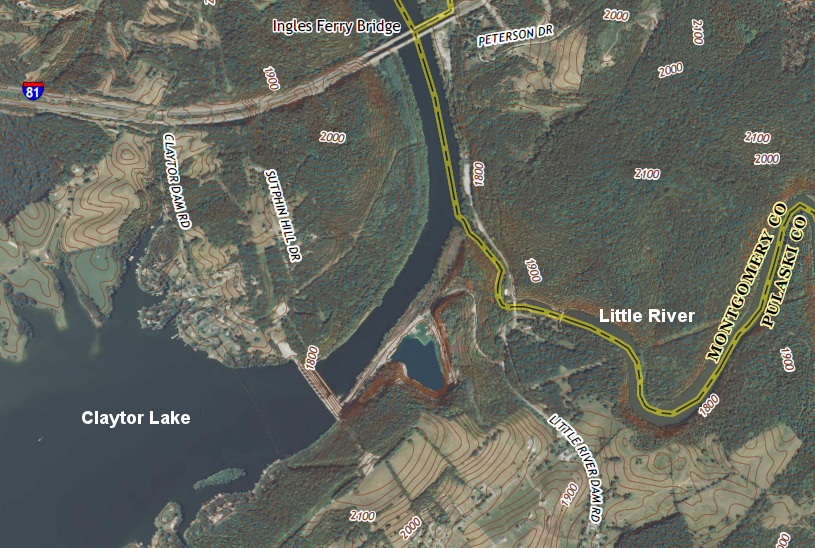
both Claytor Lake Dam on the New River and the much-smaller Little River dam take advantage of steady water flows plus topographic relief to generate electricity
Source: US Geological Survey (USGS), Radford South 7.5x7.5 topographic quad (2013, Revision 1)
Electrical generating plants rely upon a basic principal of physics: a magnet whirling within coils of copper will produce electricity, which can be transmitted through wires to customers. Locating a power plant in Virginia requires consideration of several factors, but essential for all of those facilities is finding a way to spin the magnet inside a turbine.
Electrical generating plants using hydropower must be located near running water, which provides the energy to spin the magnet - just like old mills relied upon falling water to spin large wheels that spun grinding stones to make wheat or corn meal.
Tiny versions of hydropower plants, relying upon a device called a Pelton wheel, can utilize the energy in flowing water and do not require construction of dams or diversion structures that alter the pattern of free-flowing rivers. Pelton wheels can supply electricity to an isolated mountain cabin, but are not cost-effective for generating large amounts of electricity.
Topographic relief is required to build a large-scale (1MW or greater) hydropower plant. Such facilities are built where river flows are steady as well as where topographic relief is available, so you will not find them high in the headwaters of a stream or below the Fall Line.
There is economy of scale in the electricity generation business; larger plants produce lower-cost electricity. As a result, many old and small hydroelectric plants - such as Lake Jackson in Prince William County - have shut down. Fairfax County once generated electricity at the Occoquan Reservoir, but abandoned its license because the cost to operate/maintain the equipment exceeded the revenue.
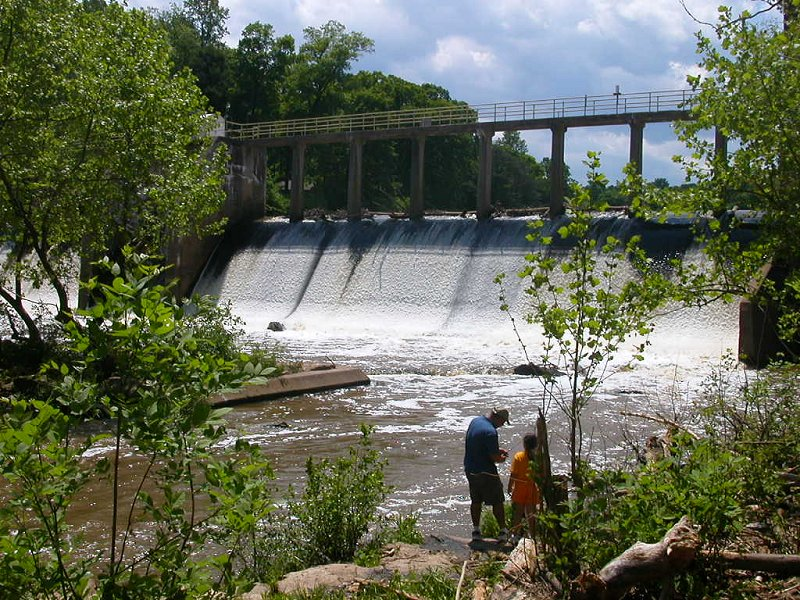
Lake Jackson Dam (Prince William County) was built to generate hydropower, but now provides just recreational and stormwater management benefits
A pumped storage hydropower facility requires two things: an adequate supply of water, and topographic relief so mechanical energy of falling water can be converted into electricity. Pumped storage hydropower plants can be located further upstream than standard hydropower plants, because the water is stored and recycled rather than lost downstream.
Pumped storage plants are economical because electricity can not be stored effectively. In the Bath County and Smith Mountain Lake pumped storage facilities, water is pumped back and forth between two reservoirs. The water is dropped through turbines to create hydropower when needed for peak periods. When demand is low, electricity provided by a coal-or nuclear-powered plant is used to pump the water back into the upper reservoir.
The power company (VEPCO at the time) built a pumped storage facility in Bath County because the location had the necessary change in elevation, plus lots of land available at a low price. There was enough water for hydropower, after damming up the creek - but not enough water to use it just once. It had to be conserved by pumping the water back uphill. That is costly and rather unusual, but it allows the utility to generate electricity only when demand peaks.
Overall, the pumped storage facility uses more power than it generates - but it can produce relatively cheap power when demand is high. The alternative to a peak power plant, a baseload coal-fired or nuclear power plant that would operate 24 hours a day, would generate electricity at a lower cost per kilowatt... but much of that power would be wasted during periods of low demand, making pumped storage a cost-effective solution.
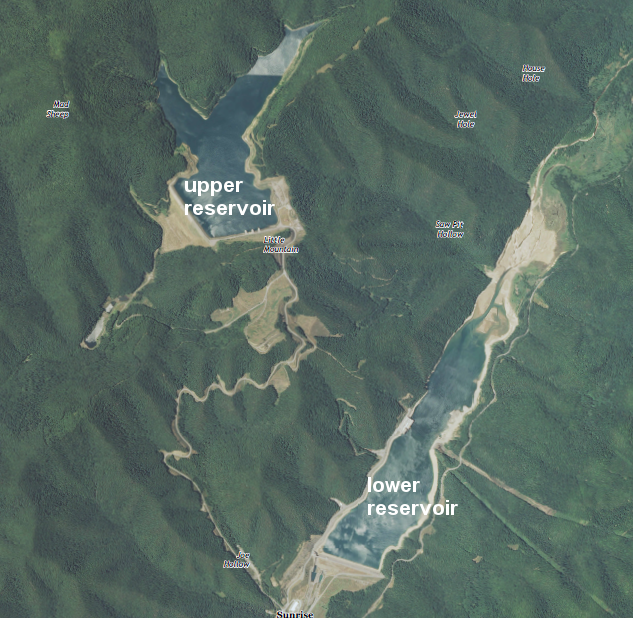
the Bath County Pumped Storage Station, like Smith Mountain Lake, is designed to generate electricity from hydropower at times of peak demand
Source: US Geological Survey (USGS), Sunrise 7.5x7.5 topographic quad (2013, Revision 1)
The location of a coal-fired power plant used to be determined by three key factors:
- cost of hauling the coal to the power plant
- cost of transmission to carry the power from the plant to the consumer
- availability of cooling water
Plants used to be located close to the customers. Coal was hauled by rail from the Appalachian Plateau to the power plants on rivers near Richmond, Danville, Alexandria, etc. The James, Dan, Potomac, and other rivers provided water for cooling the steam that powered the turbines at electricity generating plants.
To reduce the costs of hauling coal, utilities changed the pattern. They built coal-fired power plants closer to the mines, using high-voltage transmission lines to ship the electricity to the urban centers. Some of the energy is lost in transmission through power lines due to electrical resistance. Raising the voltage reduces the loss, though substations and transformers must be built near the ultimate consumers to lower the voltage to the 110/220 circuits used in Virginia homes.
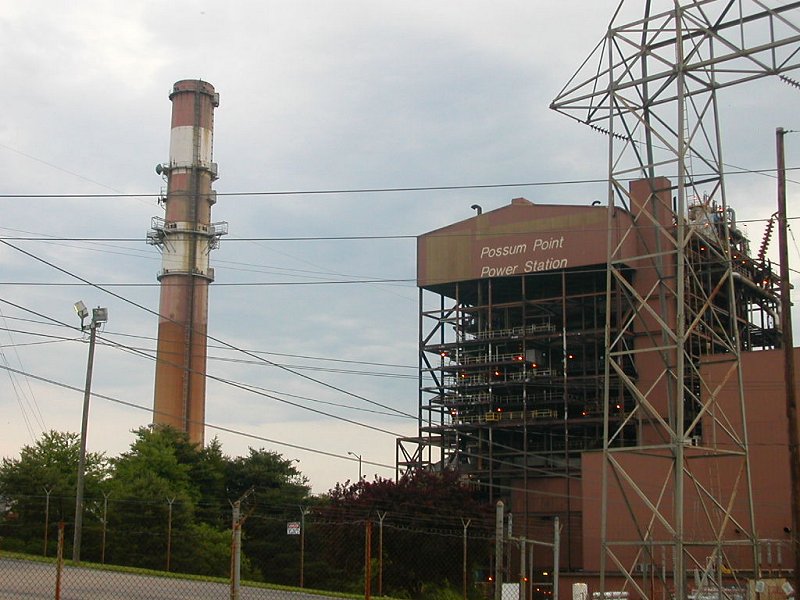
Possum Point power plant in Prince William County is now fueled by natural gas instead of coal or petroleum, to help meet air quality standards
The new, fourth factor for locating coal-fired power plants now is air quality. Power plants produce byproducts from the combustion of the coal, especially sulfur dioxide (SO2 and nitrogen oxide (NOx) compounds and particulates (tiny particles that can trigger lung disease).
Closing power plants in urban areas, and using high-voltage transmission lines to supply power generated at a distance, can help a region meet National Ambient Air Quality Standards and prevent significant deterioration of existing air quality. For example, the Clover Power Plant in Halifax County and the Virginia City Hybrid Energy Center in Wise County were built in areas where air quality could be degraded without dropping below the standards set by the Environmental Protection Agency (EPA).
However, pollutants emitted from power plants still travel downwind. Coal-fired power plants on the Ohio River are a major contributor to air pollution in Shenandoah National Park. Wind currents carry unnatural haze-forming chemicals to Virginia, obscuring the scenic views.
There was a natural haze formed from chemicals emitted from trees in the Blue Ridge and the Smoky Mountains - that is why early settlers created those names - but the human-created pollution is overwhelming the natural levels. Tourist official worry that business will drop, if the vistas are diminished.

effect of air pollution on visibility from Shenandoah National Park
Source: National Park Service, Preserving Air Quality in National Parks
Nuclear power plants do not generate air pollution, not even carbon dioxide (CO2). Like coal-fired power plants, the two nuclear power plants in Virginia were located close to customers to reduce cost of transmitting electricity. Both were sited away from urban centers, in consideration of potential evacuation requirements.
Both were supposedly located at sites where earthquakes were unlikely. However, later investigation revealed that the North Anna plant was constructed on top of a geologic fault. Both the utility and Federal regulators engaged in a cover-up to permit construction to continue. As noted later by the William and Mary geologists who examined the site prior to construction:1
- Steve Clement noted that "the fault was a classic example that I'd expect most undergraduate students to recognize" and Bruce Goodwin said of a VEPCO representative "he’d have to have been asleep not to know there was a fault."
The North Anna plant was located where a railroad spur could be constructed to bring heavy equipment to the site, including the fuel cells loaded with radioactive material. The Surry Plant was built where barges could provide equivalent transportation service.
However the most important factor in siting both facilities was the availability of water to cool the steam that spins magnets to generate electricity. The Surry County plant pulls its cooling water from the James River.
The Louisa County nuclear power plant was constructed near the area of growing customer demand, Northern Virginia. The utility had to build a dam across the South Anna River to construct Lake Anna, in order to ensure an adequate cooling water supply. The lake now has a "hot side" where the water discharged from the power plant is 14 degrees warmer than the intake water. Cooling ponds were built on that side of the lake to manage the temperature differential, and the state regulated hat section of Lake Anna as a waste treatment facility instead of as a public waterway.2
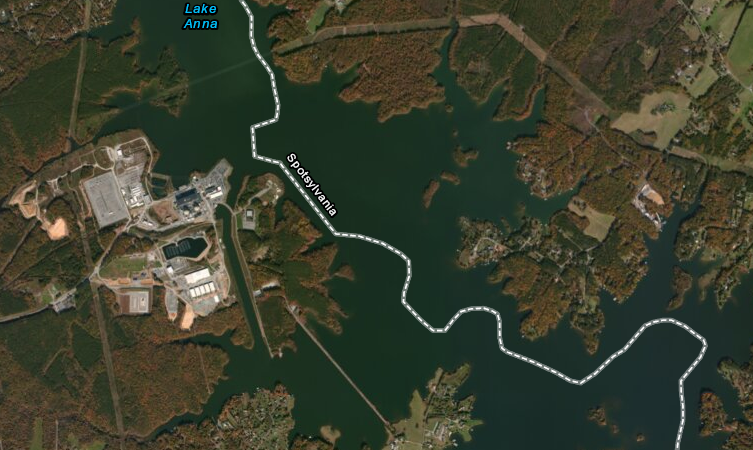
the "hot side" of Lake Anna - the southern side - includes cooling ponds to reduce the temperature of water from the nuclear power plant
Source: ESRI, ArcGIS Online
Coal, nuclear, and hydropower plants are big, expensive, hard-to-locate facilities. Air quality constraints limit the places where a new coal plant can be built, and we have already built dams at all the locations where we could generate electricity. Due to serious concerns over safe operations of nuclear plants and disposal of nuclear waste, there's just a slim possibility of another nuclear plant being constructed in Virginia anytime soon.
However, natural gas power plants can be constructed in lots of places. The utilities using natural gas need one thing - a pipeline bringing gas. Natural gas turbines can be used intermittently throughout the day to meet demand, serving as a peaking plant. The City of Manassas operates such a facility. With the reduction in the cost of natural gas after the fracking boom, utilities are even building baseload power plants fueled by natural gas, such as Dominion Power's $1.3 billion facility in Brunswick County.
The pattern of generating electricity at massive facilities could change. The scale-dependent economics that shape coal-fired and nuclear-fired facilities have less influence over natural gas-fired power plants.
The greatest shift could occur if solar power becomes a cost-effective alternative. Solar cells on millions of rooftops would create a distributed rather than centralized pattern of electrical generation. If consumers invest in generating their own electricity over the next 30 years, then utilities could become a supplier-of-last-resort rather than the preferred source of electricity.
Such a scenario would create "stranded costs" for utilities and companies that built new power plants to sell electricity to utilities. Multi-billion dollar investments that were expected to generate profits for 40 years could become white elephants, if customers reduce their demand rapidly.
The State Corporation Commission (SCC), which must approve new power plants in Virginia for investor-owned utilities, discounts this scenario and continues to approve large new plants. The General Assembly continues to reject proposals for subsidizing installation of solar power at individual homes, or even mandating utilities generate a minimum percentage of their electricity from renewable resources. (The state's Renewable Portfolio Standard is just recommended.)
There is no guarantee that the economics of today define a steady trend line. The economics of the future could be disrupted in the electricity market, with impacts comparable to those experienced by booksellers after the advent of the internet. Government regulations can change after elections change government policies and priorities, as occurred in November 2016 with the election of President Trump.
If decentralized power became common, or if homeowners invest in geothermal systems that minimize the need for electricity for heating/cooling, then the transmission network that distributes electricity could also be affected. The telephone network has already been altered, as cell phones have replaced landlines.
Electrical service is so essential it is unlikely that homeowners would "cut the cord" and eliminate the option of receiving electricity from the network. Future electrical bills for homes with solar cells may include a line item for maintaining connectivity that costs more than the line item for purchased electricity.

solar cells on house in Loudoun County
References
1. "Memo says utility, U.S. covered up fault line's existence," Richmond Times-Dispatch, November 6, 2011, http://www.timesdispatch.com/business/memo-says-utility-u-s-covered-up-fault-line-s/article_8a6fe8e4-56b1-5c0b-963b-fe52d868b75b.html;
Chuck Bailey, "North Anna Whose Fault is It? The 2011 Virginia Earthquake (Part
2)," William and Mary blogs, http://blogs.wm.edu/2012/01/09/whose-fault-is-it-the-2011-virginia-earthquake-part-2/
(last checked November 11, 2013)
2. "North Anna - Waste Heat Treatment Facility," Dominion Power, https://www.dom.com/about/stations/nuclear/north-anna/waste-heat-treatment-facility.jsp; "Judge: Nuclear plant's wastewater discharge was wrong," The Virginian-Pilot, February 24, 2009, http://hamptonroads.com/2009/02/judge-nuclear-plants-wastewater-discharge-was-wrong (last checked November 11, 2013)
Virginia Places






